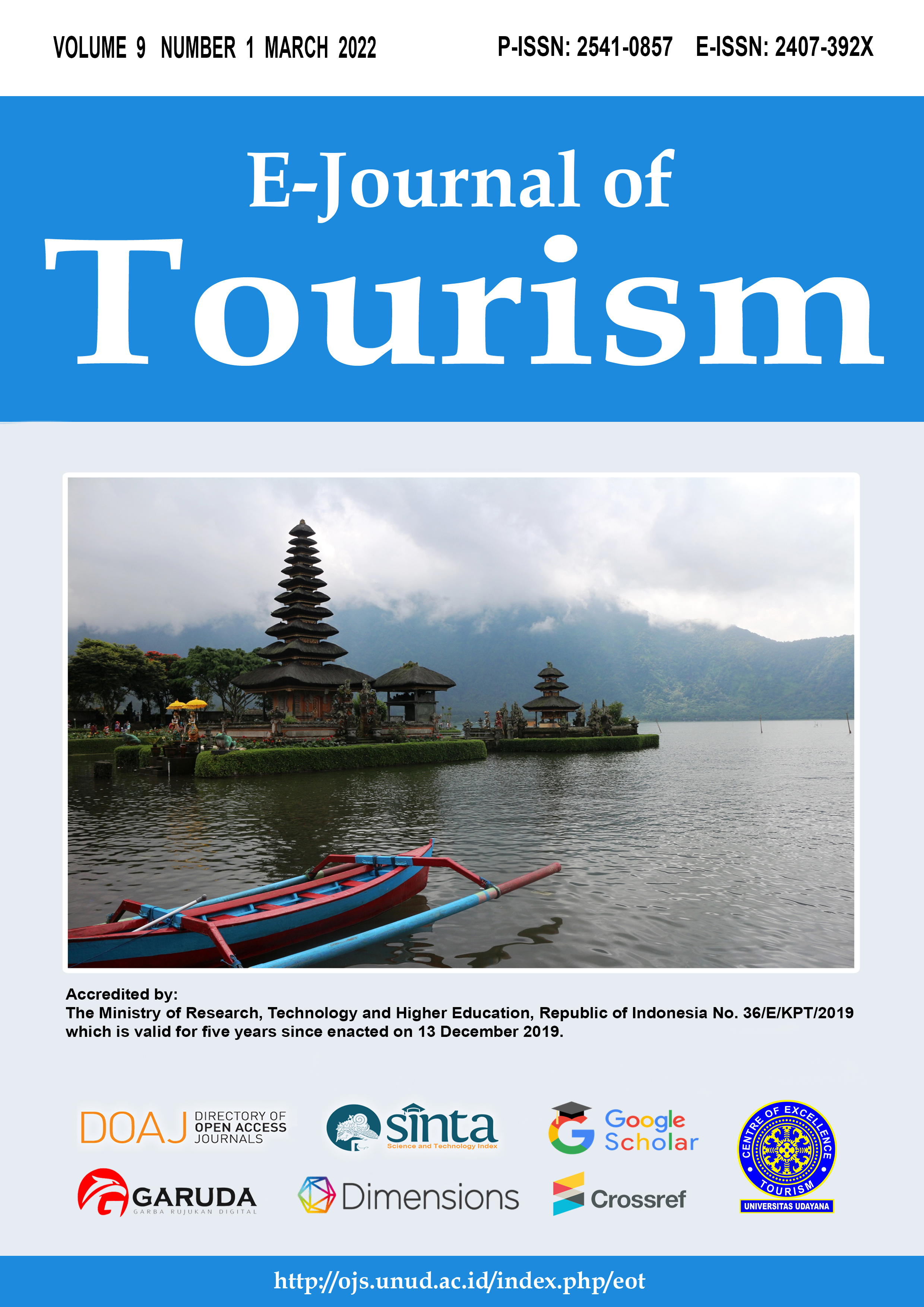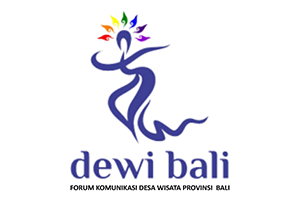Slow Tourism Possibilities in Cimande Tourism Village – West Java
Abstract
Cimande Tourism Village is a village located in Tarikolot, Bogor Regency, Indonesia. It has a lot of tourism potential, both natural tourism, cultural tourism, and artificial tourism. This green, calm and cultural area is expected to be able to provide alternative types of tourism that are thick with experience and also have a significant economic impact by extending the length of stay of tourists. The purpose of this research is to see how much potential Cimande Tourism Village has to be applied as slow tourism. Slow tourism is a form of tourism theme which stresses quality in gaining experience during tourism activities rather than quantity. The study used descriptive qualitative methods. A checklist is given to tourism academics whose results are recapitulated and then analyzed and described clearly. The results found that most of the key elements of slow tourism could be found and it could also be applied in order to establish the form of slow tourism as alternative tourism. This research only focuses on the supply side from an academic perspective. Slow tourism is not a common form of tourism, in Indonesia, no research has ever been conducted on slow tourism before, and this paper is expected to be an early opening door in tourism research in Indonesia, especially in them of slow tourism.
Keywords: Slow Tourism, alternative tourism, tourism village
Downloads
References
Anderson, E. W., Fornell, C., & Lehmann, D. R. (1994). Customer Satisfaction, Market Share, and Profitability: Findings from Sweden. Journal of Marketing, 58(3), 53. https://doi.org/10.2307/1252310
Caffyn, A. (2012). Advocating and Implementing Slow Tourism. Tourism Recreation Research, 37(1), 77–80. https://doi.org/10.1080/02508281.2012.11081690
Christou, L.; Cyprus, N. (2012). Is it possible to combinne mass tourism with alternative forms of tourism: The case of Spain, Greece, Slovenia and Croatia. J. Bus. Adm, 11, 1–8.
Chung, J. Y., Kim, J. S., Lee, C. K., & Kim, M. J. (2018). Slow-food-seeking behaviour, authentic experience, and perceived slow value of a slow-life festival. Current Issues in Tourism, 21(2), 123–127. https://doi.org/10.1080/13683500.2017.1326470
Coyne, I. T. (1997). Sampling in qualitative research. Purposeful and theoretical sampling; merging or clear boundaries? Journal of Advanced Nursing, 26(3), 623–630. https://doi.org/10.1046/j.1365-2648.1997.t01-25-00999.x
Dangi, T. B., & Petrick, J. F. (2021). Augmenting the Role of Tourism Governance in Addressing Destination Justice, Ethics, and Equity for Sustainable Community-Based Tourism. Tourism and Hospitality, 2(1), 15–42. https://doi.org/10.3390/tourhosp2010002
Dawson, D., Karlis, G. and Heintzman, P. (2008). Slow living: Postmodern temporality, the European expereince, and the Sabbath. 12th Canadian Congress on Leisure Research.
Di Clemente, J.M.H.; Mogollón, E.; Salvo, P. and Cerro, C. A. M. (2014). Slow Tourism: An Alternative Model for Local and Tourist Development. (Jiménez, J). Chartridge Books, Oxford.
Dickinson, J. E., Lumsdon, L. M., & Robbins, D. (2011). Slow travel: Issues for tourism and climate change. Journal of Sustainable Tourism, 19(3), 281–300. https://doi.org/10.1080/09669582.2010.524704
Ernszt, I., & Marton, Z. (2021). An Emerging Trend of Slow Tourism: Perceptions of Hungarian Citizens. Interdisciplinary Description of Complex Systems, 19(2), 295–307. https://doi.org/10.7906/indecs.19.2.8
Guillemain, M., Blanc, R., Lucas, C., & Lepley, M. (2007). Ecotourism disturbance to wildfowl in protected areas: Historical, empirical and experimental approaches in the Camargue, Southern France. Biodiversity and Conservation, 16(12), 3633–3651. https://doi.org/10.1007/s10531-007-9160-z
Honore, C. (2005). In Praise of Slow: How a worldwide movement in challenging the cult of speed.
Knox, P. L. (2005). Creating ordinary places: Slow cities in a fast world. Journal of Urban Design, 10(1), 1–11. https://doi.org/10.1080/13574800500062221
Kumar, A. (2019). Slow Tourism a New Phenomenon. Journal of Emerging Technologies and Innovative Research, 6(5), 2946–2948. https://www.researchgate.net/profile/Chirag-Patel-93/publication/351637927_Slow_Tourism_a_New_Phenomenon/links/60a2c959a6fdcc88cc04ae7d/Slow-Tourism-a-New-Phenomenon.pdf
Kuzel, A. (1999). Sampling in qualitative inquiry. (In B. Crab). Sage.
Lumsdon, L. M., & McGrath, P. (2011). Developing a conceptual framework for slow travel: A grounded theory approach. Journal of Sustainable Tourism, 19(3), 265–279. https://doi.org/10.1080/09669582.2010.519438
Mair, H., Sumner, J., & Rotteau, L. (2008). The politics of eating: Food practices as critically reflexive leisure. Leisure/ Loisir, 32(2), 379–405. https://doi.org/10.1080/14927713.2008.9651415
Mayer, H., & Knox, P. L. (2006). Slow Cities: Sustainable places in a fast world. Journal of Urban Affairs, 28(4), 321–334. https://doi.org/10.1111/j.1467-9906.2006.00298.x
Medeiros, H. M. N., Guerreiro, Q. L. de M., Vieira, T. A., Silva, S. M. S. da, Renda, A. I. da S. A., & Oliveira-Junior, J. M. B. (2021). Alternative tourism and environmental impacts: Perception of residents of an extractive reserve in the brazilian amazonia. Sustainability (Switzerland), 13(4), 1–31. https://doi.org/10.3390/su13042076
Meng, B., & Choi, K. (2016). The role of authenticity in forming slow tourists’ intentions: Developing an extended model of goal-directed behavior. Tourism Management, 57, 397–410. https://doi.org/10.1016/j.tourman.2016.07.003
Parkins, W., & Craig, G. (2006). Slow Living. UNSW Press.
Pecsek, B. (2018). Slow Tourism as the sustainable alternative for urban tourism destinations. 1–28.
Sari, D. P. (2017). The Process of Making Tempe Benguk as Tourist Attraction in Kulon Progo Yogyakarta. E-Journal of Tourism, 4(2), 78. https://doi.org/10.24922/eot.v4i2.36399
Sari, D. P. (2018). Apakah Ada Peranan Aktivitas Wisata Dalam Peningkatan Ekonomi Daerah Di Kota Bogor? Barista: Jurnal Kajian Bahasa Dan Pariwisata, 5(1), 12–22.
Sari, D. P. (2018). Motivation towards Inbound Tourism: A Study of Middle East Tourist. 2(Millenial Tourism: Creative Strategies Towards sustainable tourism development in the Millenial Era), 160–169. https://www.balitourism.or.id/wp-content/uploads/2018/12/The-2nd-Bali-International-Tourism-Conference-Proceeding.pdf
Sari, D. P. (2019). Motivation towards Inbound Tourism: A Study of Middle East Tourist. E-Journal of Tourism, 6(2), 235. https://doi.org/10.24922/eot.v6i2.53474
Sari, D. P., & Batubara, R. P. (2021). E-Tourism as A Promotion Media for Cimande Tourism Village. E-Journal of Tourism, 8(1), 115. https://doi.org/10.24922/eot.v8i1.71452
Tasch, W. (2008). Inquiries into the Nature of Slow Money: Investing as if food, farms and fertility mattered. Chelsea Green.
Theng, S., Qiong, X., & Tatar, C. (2015). Études caribéennes 31-32 (Août-Décembre 2015) Tourisme de masse vs. tourisme alternatif Mass Tourism vs Alternative Tourism? Challenges and New Positionings. Études Caribéennes, 32. http://etudescaribeennes.revues.org
Triarchi, E., & Karamanis, K. (2017). Alternative Tourism Development: A Theoretical Background. World Journal of Business and Management, 3(1), 35. https://doi.org/10.5296/wjbm.v3i1.11198
Weaver, D. B., & Lawton, L. J. (2007). Twenty years on: The state of contemporary ecotourism research. Tourism Management, 28(5), 1168–1179. https://doi.org/10.1016/j.tourman.2007.03.004
Winarno, S. (2004). Pengantar Penelitian Ilmiah, Dasar, Metode, dan Teknik. Tarsito.
World Travel and Tourism Council (WTTC). (2021). World - Economic Impact 2021. Global Economic Impact & Trends 2021, 1–2. https://wttc.org/Portals/0/Documents/EIR/EIR2021 Global Infographic.pdf?ver=2021-04-06-170951-897

This work is licensed under a Creative Commons Attribution 4.0 International License.
The copyright of the received article shall be assigned to the journal as the publisher of the journal. The intended copyright includes the right to publish the article in various forms (including reprints). The journal maintains the publishing rights to the published articles.




















